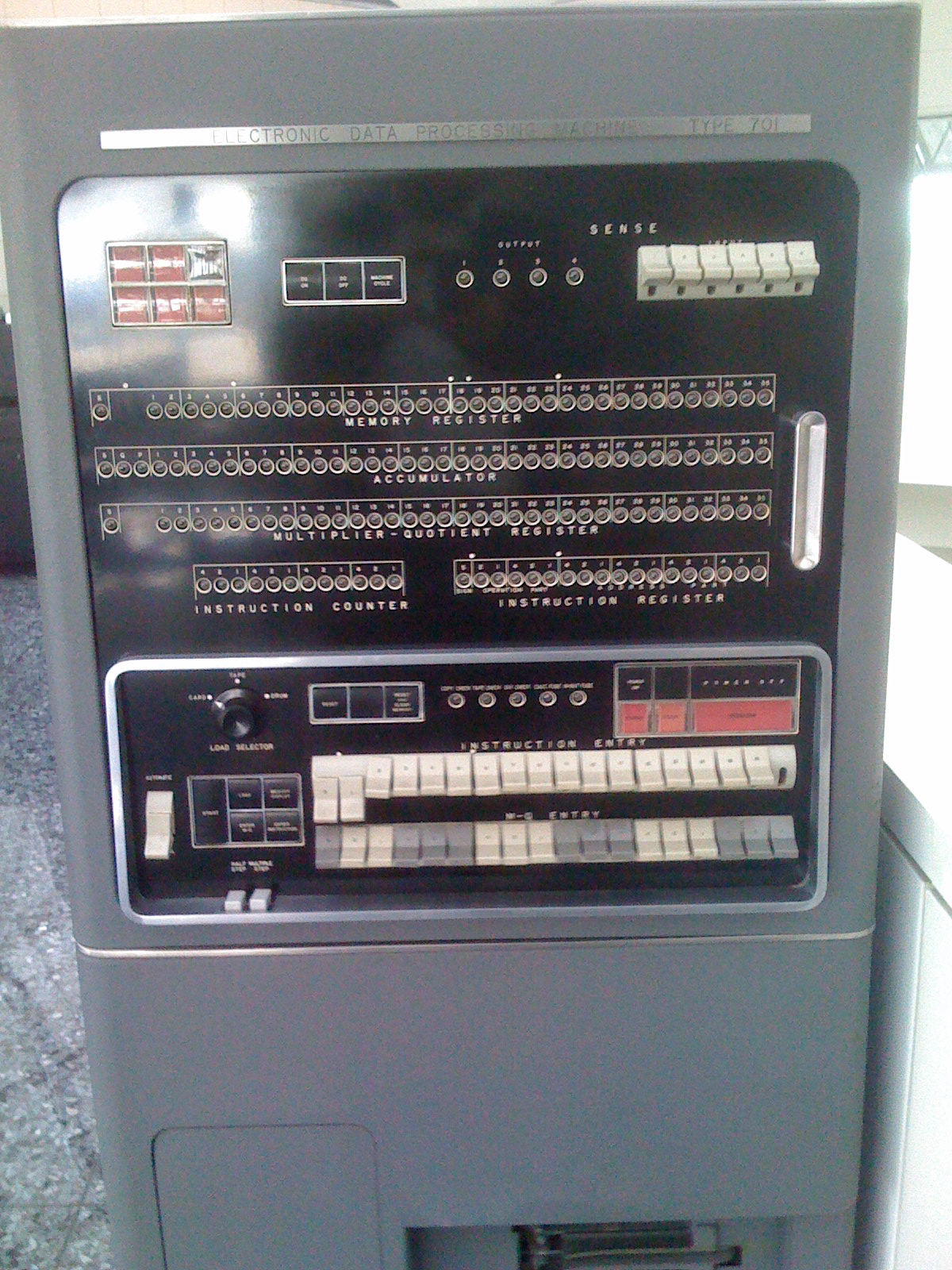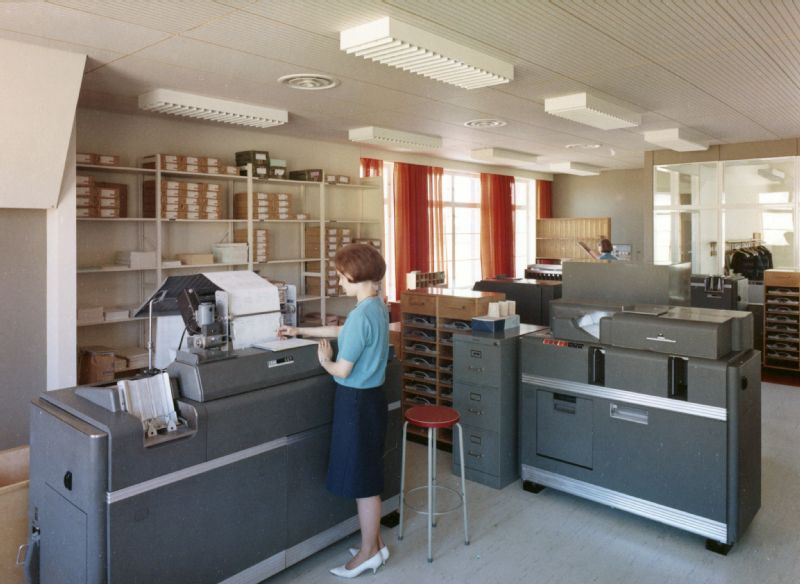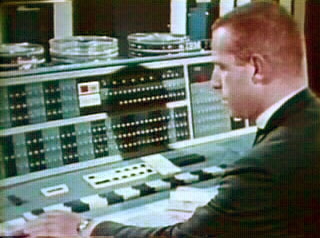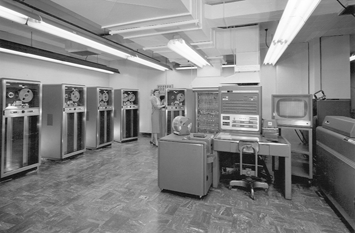|
IBM 716
The IBM 716 line printer was used with IBM 700/7000 series computers in the 1950s and 1960s. It was introduced on May 21, 1952 with the IBM 701 The IBM 701 Electronic Data Processing Machine, known as the Defense Calculator while in development, was IBM’s first commercial scientific computer and its first series production mainframe computer, which was announced to the public on May ... and withdrawn from marketing on July 14, 1969. Overview The 716 was based on IBM 407 accounting machine technology and had 120 rotary type wheels, each with 48 possible characters. It could print 150 lines per minute. It also supplied power to the IBM 711 card reader and 721 card punch. Only 72 characters could be transferred from IBM 7090 computer to the 716 in a single operation, but a full line could be printed at half speed. Characters were printed by sending bit patterns that corresponded to the impulses that a 407 would see when reading a punched card. [...More Info...] [...Related Items...] OR: [Wikipedia] [Google] [Baidu] |
List Of IBM Products
The following is a partial list of products, services, and subsidiaries of International Business Machines (IBM) Corporation and its predecessor corporations, beginning in the 1890s. This list is eclectic; it includes, for example, the '' AN/FSQ-7'', which was not a product in the sense of ''offered for sale'', but was a product in the sense of ''manufactured—produced by the labor of IBM''. Several machines manufactured for the Astronomical Computing Bureau at Columbia University are included, as are some machines built only as demonstrations of IBM technology. Missing are many RPQs, OEM products (semiconductors, for example), and supplies (punched cards, for example). These products and others are missing simply because no one has added them. IBM sometimes uses the same number for a system and for the principal component of that system. For example, the IBM 604 Calculating Unit is a component of the IBM 604 Calculating Punch. And different IBM divisions used the same mo ... [...More Info...] [...Related Items...] OR: [Wikipedia] [Google] [Baidu] |
Line Printer
A line printer prints one entire line of text before advancing to another line. Most early line printers were impact printers. Line printers are mostly associated with unit record equipment and the early days of digital computing, but the technology is still in use. Print speeds of 600 lines per minute (approximately 10 pages per minute) were achieved in the 1950s, later increasing to as much as 1200 lpm. Line printers print a complete line at a time and have speeds in the range of 150 to 2500 lines per minute. The types of line printers are drum printers, band-printers, and chain printers. Other non-impact technologies have also been used, as thermal line printers were popular in the 1970s and 1980s, and some inkjet and laser printers produce output a line or a page at a time. Designs Many impact printers, such as the daisywheel printer and dot matrix printer, used a print head that printed a character then moved on until an entire line was printed. Line printers ... [...More Info...] [...Related Items...] OR: [Wikipedia] [Google] [Baidu] |
IBM 700/7000 Series
The IBM 700/7000 series is a series of large-scale (mainframe) computer systems that were made by IBM through the 1950s and early 1960s. The series includes several different, incompatible processor architectures. The 700s use vacuum-tube logic and were made obsolete by the introduction of the transistorized 7000s. The 7000s, in turn, were eventually replaced with System/360, which was announced in 1964. However the 360/65, the first 360 powerful enough to replace 7000s, did not become available until November 1965. Early problems with OS/360 and the high cost of converting software kept many 7000s in service for years afterward. Architectures The IBM 700/7000 series has six completely different ways of storing data and instructions: *First scientific (36/18-bit words): 701 (Defense Calculator) *Later scientific (36-bit words, hardware floating-point): 704, 709, 7040, 7044, 7090, 7094 *Commercial (variable-length character strings): 702, 705, 7080 * 1400 series (variab ... [...More Info...] [...Related Items...] OR: [Wikipedia] [Google] [Baidu] |
IBM 701
The IBM 701 Electronic Data Processing Machine, known as the Defense Calculator while in development, was IBM’s first commercial scientific computer and its first series production mainframe computer, which was announced to the public on May 21, 1952. It was invented and developed by Jerrier Haddad and Nathaniel Rochester based on the IAS machine at Princeton. The IBM 701 was the first computer in the IBM 700/7000 series, which were IBM’s high-end computers until the arrival of the IBM System/360 in 1964. The business-oriented sibling of the 701 was the IBM 702 and a lower-cost general-purpose sibling was the IBM 650, which gained fame as the first mass-produced computer in the world. History IBM 701 competed with Remington Rand's UNIVAC 1103 in the scientific computation market, which had been developed for the NSA, so it was held secret until permission to market it was obtained in 1951. In early 1954, a committee of the Joint Chiefs of Staff requested that the ... [...More Info...] [...Related Items...] OR: [Wikipedia] [Google] [Baidu] |
IBM 407
The IBM 407 Accounting Machine, introduced in 1949, was one of a long line of IBM tabulating machines dating back to the days of Herman Hollerith. It had a card reader and printer; a summary punch could be attached. Processing was directed by a control panel. The 407 was the central component of many unit record equipment shops which were the mainstay of IBM's business at the time. It could print digits, letters and several special characters in any of 120 print positions, spaced . In 1976 the IBM 407 Accounting Machine was withdrawn from marketing. Description The 407 read punched cards, totaled fields on the cards, made simple decisions, printed results, and, with the aid of a summary punch, output results on punched cards that could be input to other processing steps. The operation of the 407 was directed by the use of a removable control panel and a carriage tape. Exit hubs (impulse emitting) on the control panel are wired to entry hubs (impulse accepting) for the ... [...More Info...] [...Related Items...] OR: [Wikipedia] [Google] [Baidu] |
IBM 711
The IBM 711 was a punched card reader used as a peripheral device for IBM mainframe vacuum tube computers and early transistorized computers. Announced on May 21, 1952, it was first shipped with the IBM 701. Later IBM computers that used it were the IBM 704, the IBM 709, and the transistorized IBM 7090 and 7094. Overview The 711's read mechanism was based on the IBM 402's and could read 150 cards per minute (250 cards per minute on the IBM 7090). It included a control panel that could be wired to transfer any 72 columns out of the 80 on a card into the computer's memory, though in practice the panel was almost always wired to read the first 72 columns. Cards were read in binary format. Data from each row was read into two 36-bit words, starting with row 9, for a total of 24 words per card. Computer object code could then be executed directly. Conversion to characters or numbers was done in software. The 72 column restriction influenced early computer languages, such as Fortran ... [...More Info...] [...Related Items...] OR: [Wikipedia] [Google] [Baidu] |
IBM 7090
The IBM 7090 is a second-generation transistorized version of the earlier IBM 709 vacuum tube mainframe computer that was designed for "large-scale scientific and technological applications". The 7090 is the fourth member of the IBM 700/7000 series scientific computers. The first 7090 installation was in December 1959. In 1960, a typical system sold for $2.9 million (equivalent to $ million in ) or could be rented for $63,500 a month (). The 7090 uses a 36-bit word length, with an address space of 32,768 words (15-bit addresses). It operates with a basic memory cycle of 2.18 μs, using the IBM 7302 Core Storage core memory technology from the IBM 7030 (Stretch) project. With a processing speed of around 100 Kflop/s, the 7090 is six times faster than the 709, and could be rented for half the price. An upgraded version, the 7094 was up to twice as fast. Both the 7090 and the 7094 were withdrawn from sale on July 14, 1969, but systems remained in service for more than a ... [...More Info...] [...Related Items...] OR: [Wikipedia] [Google] [Baidu] |
IBM 702
The IBM 702 was an early generation tube-based digital computer produced by IBM in the early to mid-1950s. It was the company's response to Remington Rand's UNIVAC—the first mainframe computer to use magnetic tapes. As these machines were aimed at the business market, they lacked the leading-edge computational power of the IBM 701 and ERA 1103, which were favored for scientific computing, weather forecasting, the aircraft industry, and the military and intelligence communities. Within IBM, the 702 was notable for adapting the new technology of magnetic-core memory for random-access applications. The 702 was announced September 25, 1953, and withdrawn October 1, 1954, but the first production model was not installed until July 1955. It was superseded by the IBM 705. History Fourteen 702s were built. The first one was used at IBM. Due to problems with the Williams tubes, the decision was made to switch to magnetic-core memory instead. The fourteenth 702 was built ... [...More Info...] [...Related Items...] OR: [Wikipedia] [Google] [Baidu] |
IBM 705
The IBM 700/7000 series is a series of large-scale (mainframe) computer systems that were made by IBM through the 1950s and early 1960s. The series includes several different, incompatible processor architectures. The 700s use vacuum-tube logic and were made obsolete by the introduction of the transistorized 7000s. The 7000s, in turn, were eventually replaced with System/360, which was announced in 1964. However the 360/65, the first 360 powerful enough to replace 7000s, did not become available until November 1965. Early problems with OS/360 and the high cost of converting software kept many 7000s in service for years afterward. Architectures The IBM 700/7000 series has six completely different ways of storing data and instructions: *First scientific (36/18- bit words): 701 (Defense Calculator) *Later scientific (36-bit words, hardware floating-point): 704, 709, 7040, 7044, 7090, 7094 *Commercial (variable-length character strings): 702, 705, 7080 * 1400 series (var ... [...More Info...] [...Related Items...] OR: [Wikipedia] [Google] [Baidu] |





